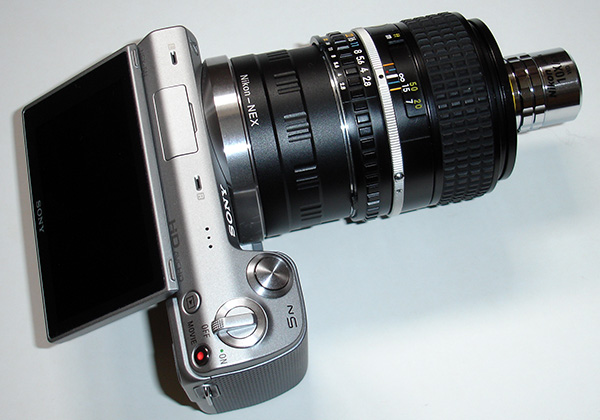A Zeiss Photomicroscope III is my main compound microscope and find that its modularity allowing quick interchange between lighting methods very useful—especially when space is at a premium. I've recently been exploring macro / low power micro just using a microscope objective. I'm rather late into trying this well established technique as many users have shared their methods and the striking imagery which can be created—see for example the photomacrography.net website.
One of the main benefits of this technique over a stereo microscope for imaging, is a comparable field of view but with the advantage of a far superior numerical aperture (NA) and thus resolution. As many users find, the zoom stereo microscope, especially those with an extended zoom range, have poor NAs at their lowest powers (see this Micscape article which studies and quantifies this). Even the big makers' flagship stereo and macroscopes suffer from this inevitable compromise to maintain the large working distances.
The downside of using a single microscope objective for macro is the small depth of field and thus many subjects can require extensive image stacking. This requires a stand for the objective which is robust, stable and with fine focus capability i.e. pretty much what a compound microscope stand delivers. It's therefore no surprise that many users modify a spare compound microscope stand for this purpose—see for example the photomacrography.net website.
I don't have room for a spare stand solely for macro use but find that the Photomicroscope allows quick and easy conversion to a macro stand—probably not a new idea for this stand but show its benefits for my own studies below.
|
Shown right is a typical setup to use a single microscope objective for macro. As the objective is an infinity design, a relay lens is required to focus it. Many users are exploring modest telephotos for this role and the lens to hand I'm trying is a Nikkor Series E 100mm f2.8 with 52 mm filter thread. The objective, a Nikon CF Plan 10X NA0.30 EPI with working distance of 16.5 mm is attached near to the front element using a 52 mm to RMS thread adaptor, the latter is readily available on eBay for a few pounds. (Safety note: If trying similar, for this objective / Nikkor lens combination, the support plate had to be padded out a few mm with card discs to prevent rear of objective touching the front lens element.) These long working distance Nikon objectives are popular for macro as they are fully corrected—an important property if used without an eyepiece. It is shown here on a Sony NEX 5N with APS sensor. Its electronic first curtain shutter mode for vibration free imaging is invaluable for this role. A Nikon-NEX adaptor is used. |
|
|
The macro setup above is shown used on a part stripped Photomicroscope PMIII. Advantages of this setup: - the PMIII's quick release nosepiece, stage and condenser can be removed readily. A spare flat metal adaptor plate is shown here on the field iris to raise the subject a plane a little to allow the PMIII focussing to be within its range. |
|
 I'm still experimenting with objective and relay lens best pairing for my own use, but the setup shown offers an NA of 0.30 with a horizontal field of view of 4.6 mm on the Sony NEX 5N. This compares with my Leica S8 APO (fully apochromatic) 1-8X, where a zoom setting of ca. 3X gives the same field of view but with my measured NA of ca. 0.07 (agrees with Leica supplied data). Thus the Nikon objective setup is capable of almost 3X the resolution cf the stereo at this field of view—if prepared to image stack where required.
I'm still experimenting with objective and relay lens best pairing for my own use, but the setup shown offers an NA of 0.30 with a horizontal field of view of 4.6 mm on the Sony NEX 5N. This compares with my Leica S8 APO (fully apochromatic) 1-8X, where a zoom setting of ca. 3X gives the same field of view but with my measured NA of ca. 0.07 (agrees with Leica supplied data). Thus the Nikon objective setup is capable of almost 3X the resolution cf the stereo at this field of view—if prepared to image stack where required.
A weakness of the setup as presented is that it lacks a method to immobilise the lens/camera on the condenser mount to ensure no lateral movement during image stacking. Especially, as in this case, if the camera cannot be remotely controlled so need to manually press the shutter. Some form of collar could be devised or clips to do this.
The setup is also proving useful for imaging with single lens microscopes, either Leeuwenhoek replicas (I own two commercial models) and, hopefully in anticipation, for assessing a beta version of the much publicised Foldscope. For this use, the single bead lens in mount is supported on a lensless adaptor attached to the Sony NEX 5N as shown right for a Leeuwenhoek replica (but with subject spindle and focus fittings removed with subject laid on the PMIII field iris e.g. on a slide) and mounted vertically as shown above. The flange of the silver adaptor sits on the condenser mount and there's room for the lens mount to slip through condenser support aperture. The condenser centring screws have to be backed off in this instance for the wider adaptor.

